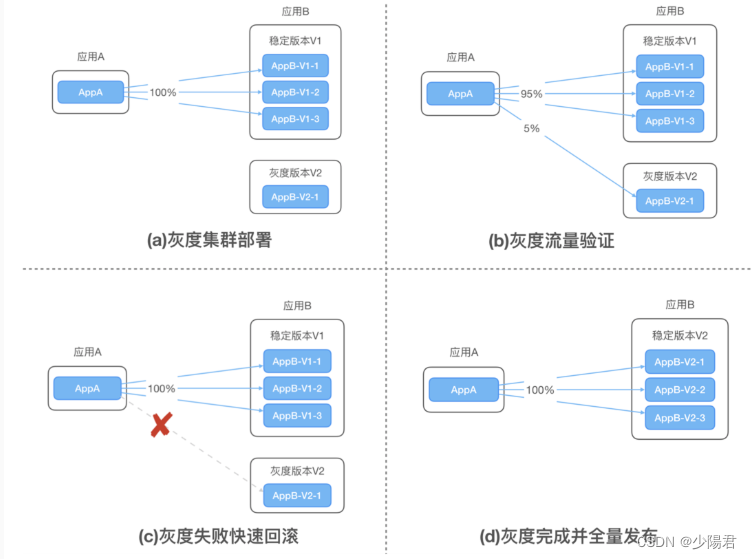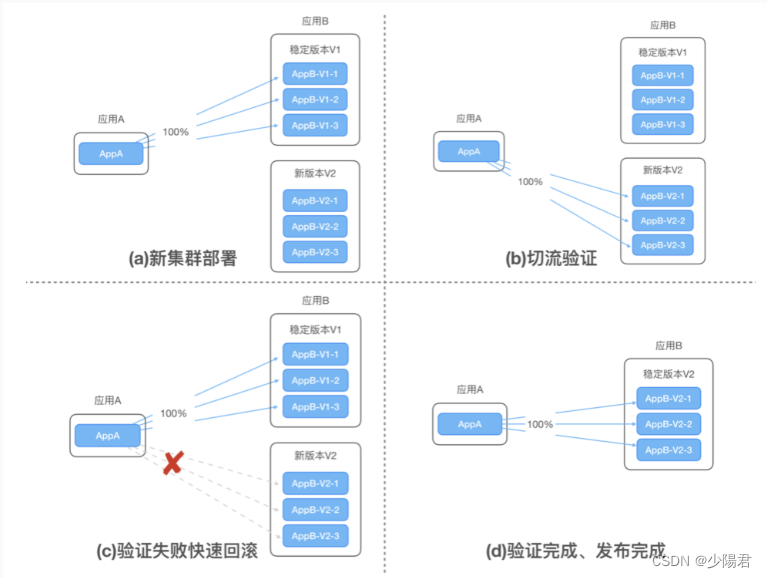The difference between blue-green release and grayscale release
Blue-green deployment and Canary release are two commonly used software release strategies for gradually introducing new versions or features. Although their goals are similar, there are some differences in implementation and effectiveness.
The following are the main differences between blue-green publishing and grayscale publishing:
-
Parallel environment: Blue-green release uses a parallel environment to deploy new and old versions of the application simultaneously, where blue represents the old version and green represents the new version. During deployment, traffic can be completely switched to the new version (green), or some traffic can continue to be routed to the old version (blue). Grayscale release does not require a parallel environment. Instead, the new version is gradually introduced into the production environment and a small portion of traffic is directed to the new version.
-
Risk management: Blue-green releases provide a mechanism for rapid rollback. If a problem is discovered during the blue-green deployment process, you can immediately switch back to the old version to reduce the scope of impact. Grayscale releases are more cautious, gradually increasing the traffic allocation to new versions to limit the scope of impact when problems arise and allowing for more granular monitoring and verification.
-
Time and scale: A blue-green release typically takes longer to complete because it involves deploying and configuring the new version in a parallel environment. In contrast, a grayscale release can happen faster because it only requires a gradual increase in traffic allocated to the new version. Blue-green releases are suitable for large-scale systems or business-critical applications, while grayscale releases are suitable for applications of all sizes.
-
User experience: Because blue-green releases support a full switch to the new version, users may experience a period of discontinuity after the switch. That's because it's actually a clear jump from the old version to the new one. Grayscale releases, on the other hand, provide a smoother transition by gradually increasing traffic allocation to the new version, and users are less likely to notice the change.
Choosing blue-green release or grayscale release depends on the specific situation and needs. If you want to be able to roll back quickly and have a parallel environment to support the switch, a blue-green release may be more appropriate. If you are more concerned with introducing new versions incrementally to minimize risk and user impact, grayscale releases may be a better option.
How to perform grayscale publishing for non-containers
Grayscale release is a method of gradually introducing new versions or features into production to reduce potential risks and ensure a smooth transition. While containerized applications have advantages in grayscale releases, there are strategies that non-containerized applications can adopt for grayscale releases as well.
Here are some common ways to grayscale release non-containerized applications:
-
Traffic Splitting: Distribute request traffic to new and old versions of applications. Offloading can be achieved using a load balancer, reverse proxy, or DNS configuration. You can initially direct a small percentage of traffic to the new version, and then gradually increase the proportion until all traffic is moved to the new version.
-
Code Switching: Control the execution paths of different versions of code by adding logic to the application. You can use conditional statements, specific URL paths, or other flags to decide whether to use a newer or older version of your code. As needed, the execution path of the new version of the code can be gradually increased.
-
A/B testing: Split traffic into two or more groups and serve each group a different version of a specific feature. By collecting user feedback, performance indicators and other key indicators, we can compare the results of different versions to help decide whether to continue to promote the new version.
-
Specific user groups or environments: Limit new versions of your application to specific user groups or environments, such as internal employees, test teams, or pre-release environments. This allows new releases to be tested and validated within a limited scope without impacting all users.
-
Build a parallel environment: Build a parallel environment similar to the production environment outside the production environment. This environment is used for grayscale release and testing of new versions. This avoids potential risks to production environments and allows for gradual switchover and rollback to older versions.
Regardless of the approach taken, grayscale releases of non-containerized applications need to ensure appropriate monitoring, error handling, and rollback mechanisms so that a stable state can be restored in a timely manner if issues arise. In addition, good communication and coordination are key to ensure that the team and relevant stakeholders have a clear consensus on the plan and process for grayscale release.


How to perform blue-green release without containers
Blue-green releases are a method of achieving a smooth transition by deploying new and old versions of an application simultaneously in a production environment. This approach ensures high availability and stability during the migration process. While blue-green releases are often associated with containerized applications, similar strategies can be employed for non-containerized applications.
Here are the general steps for blue-green releases of non-containerized applications:
-
Prepare a parallel environment: Build a parallel environment similar to the production environment. This environment needs to have the same infrastructure, configuration, and dependencies as the production environment. Ensure that the parallel environment and the applications and databases within it are synchronized with the production environment.
-
Deploy new version: Deploy a new version of the application in a parallel environment. This can include deploying new code to application servers, updating databases, and other necessary operations. Ensure new releases run properly in a parallel environment, with appropriate testing and validation.
-
Route traffic: direct a small portion of traffic from production to parallel environments (blue-green deployment). For example, you can use a load balancer or reverse proxy to distribute traffic. This way, only a small percentage of user requests are redirected to the new version, while most users still use the old version.
-
Monitor and verify: Closely monitor the health of new releases during blue-green deployments. Collect key metrics, logs, and user feedback and compare to older versions. Ensure that the new version's performance and stability under load meet expectations.
-
Gradually increase traffic: As confidence in the new version increases, you can gradually increase the traffic allocated to the new version. By gradually increasing traffic, potential problems can be better identified and rolled back to older versions in a timely manner.
-
Rollback and cleanup: If serious problems are discovered during the blue-green deployment process, you need to roll back to the old version immediately. Ensure you have strategies and procedures for rapid rollback and perform necessary cleanup and recovery operations as needed.
Blue-green releases of non-containerized applications require careful planning and coordination. Ensure the team fully understands the process and risks of blue-green releases and is prepared to deal with issues that may arise. At the same time, appropriate automation tools and continuous integration/delivery processes can also provide convenience and simplify the management and execution of blue-green releases.


Reference:
Youzan grayscale publishing and blue-green publishing practices